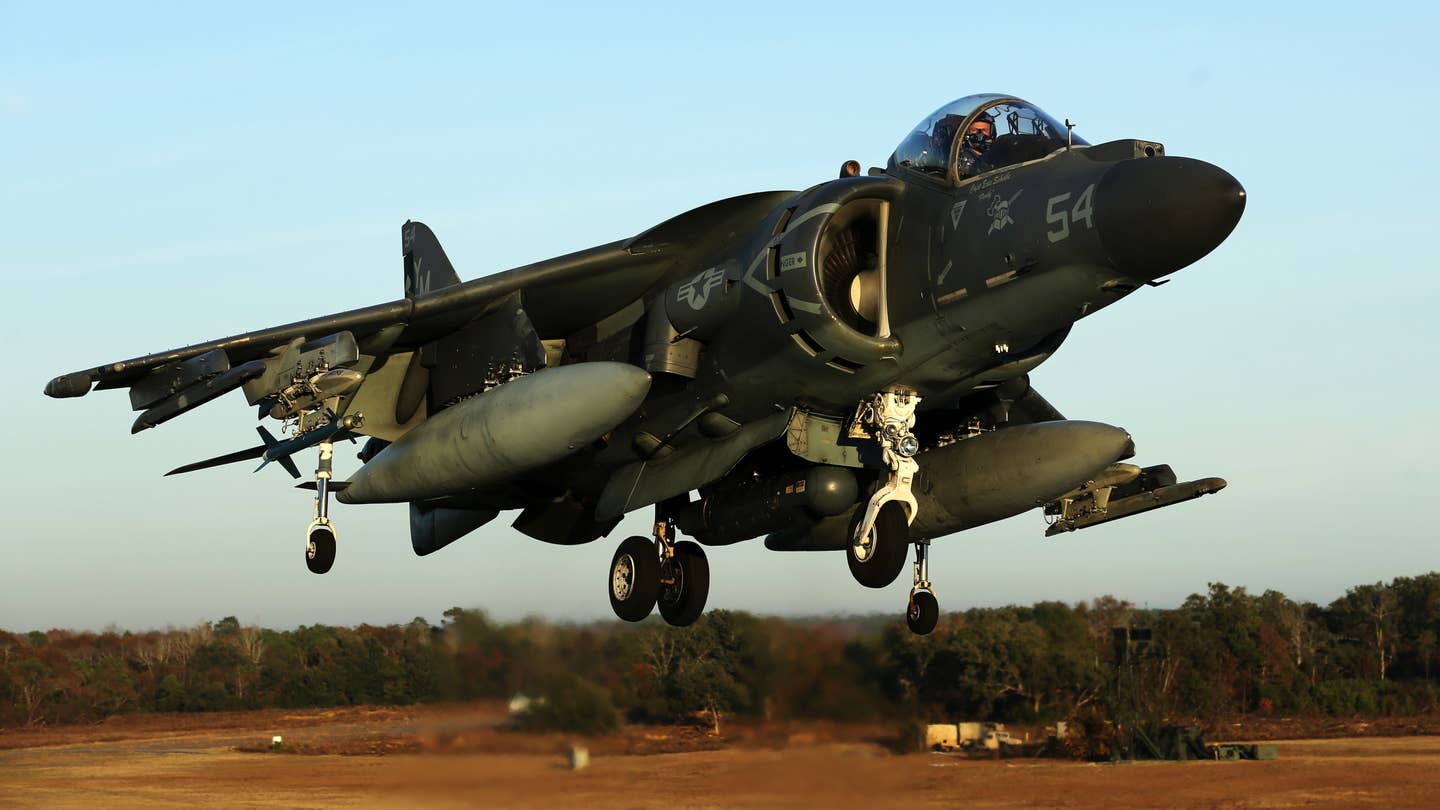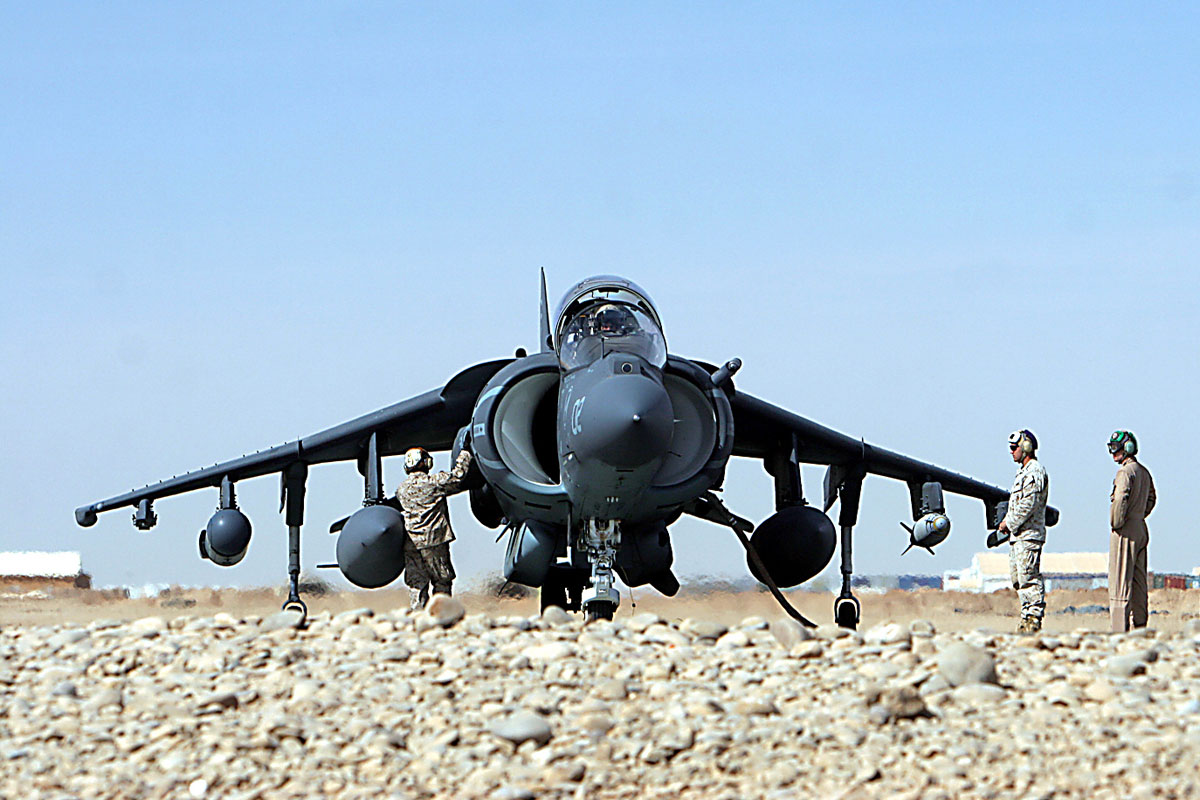Diving from 10,000 feet, Marine Corps Capt. Eric Albright’s AV-8B Harrier II rocketed toward the Afghan countryside below. It was the middle of the night, and everything beyond the jet’s glass canopy was pitch black. Albright knew somewhere in the green world of his night vision the ground was screaming toward him at 620 miles per hour.
Undaunted, Albright kept his targeting system locked on one of the four Taliban soldiers burying an IED. As the window to recover from the dive narrowed, Albright unleashed a burst from the strike aircraft’s five-barreled GAU-12/U Equalizer machine gun. Albright watched the man disappear in a flurry of 25mm rounds. The three others scattered like cockroaches, only to be captured by Marines waiting in the darkness.

A US Marine Corps AV-8B Harrier conducts flight operations aboard the Wasp-class amphibious assault ship USS Kearsarge (LHD 3) in the Atlantic Ocean, June 27, 2022. US Marine Corps photo by Sgt. Armando Elizalde.
Albright pulled the nose of the Harrier jet skyward as his vectored thrust engines sent him disappearing back into the Afghan night. This was just one of 159 combat missions Albright flew over a six-month period. It was Helmand province in 2012, and Harriers were in high demand.
When it comes to close air support, most praise goes to the A-10 Warthog. Its 30mm autocannon and the thunderous BRRRRRRT it makes with every strike make “The Hog” a favorite among troops on the ground. But the Harrier’s increased firepower and short takeoff capability make it the true king of close air support.
What Makes the Harrier Jet So Unique?
During the Korean War, NATO forces realized the advantages of having aircraft capable of vertical takeoff, such as helicopters. As soon as helicopters revealed the value of inserting and extracting troops and supplies without the need for an airfield, NATO leaders sought to design a “jump jet” with the same capability.
A US Marine Corps AV-8B Harrier with Marine Attack Squadron (VMA) 214, 11th Marine Expeditionary Unit, conducts flight operations aboard Wasp-class amphibious assault ship USS Essex. US Marine Corps photo by Cpl. Seth Rosenberg.

American aircraft manufacturer Mcdonnell Douglas and British aerospace manufacturer Hawker Siddeley collaborated to make such an aircraft a reality. In 1967, the Harrier jet became the first fixed-wing aircraft to successfully conduct vertical/short takeoff and landing operations. Equipped with a Rolls Royce engine and rotating jet nozzles, the Harrier jet could take off and land in extremely confined spaces — giving it the ability to deploy nearly anywhere in the world.
The British Royal Air Force fielded the first generation of Harriers in 1969. The United States Marine Corps recognized the value of having such aircraft for duty aboard aircraft carriers — where space is limited — and procured 110 of their own over the next eight years.
The Harrier Gets a Heavy-Weapon Facelift
In 1980, the Royal Navy developed a maritime version known as the Sea Harrier. The new naval jet fighter came with anti-ship missiles and corrosion-resistant alloys to protect against salt water. Three years later, the Marines had their own upgraded version: the AV-8B Harrier II.

US Marine Corps Capt. Eric Scheibe, AV-8B Harrier pilot with Marine Attack Squadron (VMA) 231, Marine Aircraft Group 14, 3rd Marine Aircraft Wing (Forward), conducts an aerial refuel over southern Helmand province, Afghanistan, on Dec. 6, 2012. US Marine Corps photo by Cpl. Gregory Moore.
The AV-8B was upgraded with a digital cockpit and infrared sensors to aid in night missions. Forty years later, Harriers remain some of the most heavily armed attack aircraft in history. In addition to the five-barreled Equalizer, the Harrier jet contains seven hardpoints, or positions capable of attaching munitions. Harriers can carry a variety of rockets, missiles, and bombs totaling 9,200 pounds of munitions. Despite the massive payload loved by ground forces, the Harrier is not without its flaws.
The Widow-Maker
The Harrier jet is one of the most accident-prone aircraft in aviation history. By 2002, the Marine Corps lost more than one-third of its Harriers — and 45 pilots — to accidents, earning it the nickname “The Widow-Maker.” The LA Times called it the most dangerous aircraft in the US military.
Aviation Ordnance Marines with Marine Medium Tiltrotor Squadron 161 (Reinforced) secure a laser-guided training round (LGTR) onto an AV-8B Harrier aboard amphibious assault ship USS America (LHA 6), July 16, 2017. US Marine Corps photo by Lance Cpl. Jacob Pruitt.
The Harrier jet’s high rate of major accidents dwarfs its close air support brethren. With an average of 11.44 accidents per 100,000 flight hours, the Harrier is three times more likely to crash than the F/A-18 and five times more likely than the A-10.
The Future of America’s First Jump Jet
The Harrier’s reputation for being accident-prone is finally leading to the replacement of the famous jump jet, though three Marine attack squadrons still fly them. The capability that once made the Harrier so unique — its vertical lift — is now becoming commonplace in newer, better aircraft. All remaining United States Marine and Navy Harriers are scheduled to be replaced by the F35.
Marine Corps Capt. Jonathan Lewenthal, AV-8B Harrier pilot with Marine Attack Squadron (VMA) 231, Marine Aircraft Group 14, 3rd Marine Aircraft Wing (Forward), flies over southern Helmand province, Afghanistan, after conducting an aerial refuel on Dec. 6, 2012. US Marine Corps photo by Cpl. Gregory Moore.
America’s most advanced fighter has had only five serious mishaps since entering military service in 2015 — a substantial improvement upon the Harrier’s spotty safety record. However, the F35 comes with a price tag three times that of the Harrier, slowing the transition to the newer aircraft. The United States expects to fully replace the Harrier by 2025.





